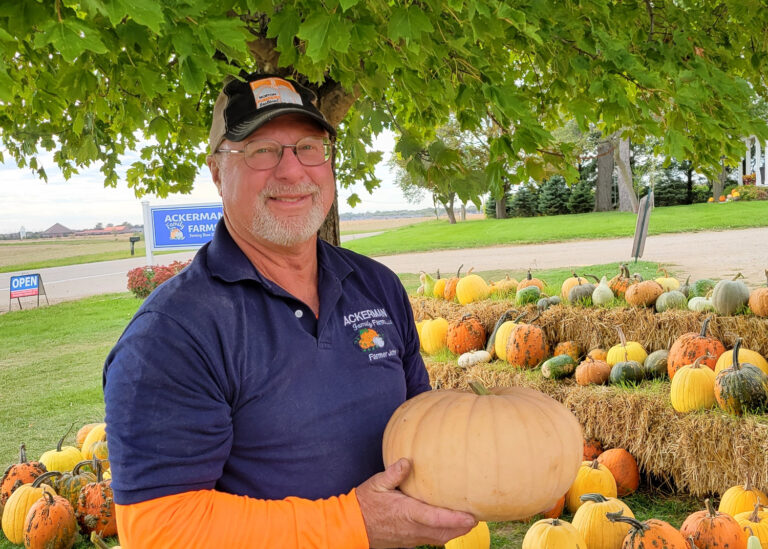Drought has affected several pumpkin-producing states, including Illinois, Indiana and Michigan. But rain arrived at the right time to produce a bumper crop in parts of the Midwest.
John Ackerman says his pumpkin crop was a good one this year, despite the fact his fields saw no measurable rainfall for weeks in the late spring and early summer.
“You know pumpkins, they like it dry but not too dry, and they was getting bad,” said Ackerman.
Then rain came just as it was needed for Ackerman, a third-generation farmer who grows pumpkins, corn, soybeans and wheat on his farm in Tazewell County, Illinois.
“We are so blessed that we caught enough rains to end up with a magnificent harvest,” he said. “Pumpkins look great this year.”

The pumpkin crop turned out well despite dry conditions throughout much of Illinois, the nation’s top producer of pumpkins, as well as in Indiana and parts of Michigan. But Texas pumpkin growers didn’t fare as well. AgriLife, the Texas A&M extension service, reports that yields are down 20%-40% this year in parts of the state where pumpkin farming is most prevalent.
While drought conditions were fairly mild in Michigan, yields are down at Johnson’s Pumpkin Farm, outside Saginaw. Mike Houghtaling, who owns the farm with his wife Erin, says they were hit by drought in May and June, then flooding on his land during July and August.
“When it’s too dry, you don’t have any moisture to get the seed to germinate and grow,” explained Houghtaling.
Then they got too much rain.
“And no plant — I don’t care what crop it is — it doesn’t want to have standing water,” he added.
Still, Houghtaling says his farm is getting by, while other pumpkin farmers in Michigan had better yields, depending on their location and soil type.
Jack-o-lanterns vs. pumpkin pie
Six states grow the lion’s share of the U.S. pumpkin crop: Illinois, Indiana, California, Michigan, Pennsylvania and Virginia. Together, they produced about 1.2 billion pounds of pumpkins in 2022, according to the U.S. Department of Agriculture.
While most of the big pumpkin-producing states focus on growing decorative pumpkins, Illinois is the exception.
The nation’s top producer of pumpkins is mostly focused on pumpkins grown for food, primarily to be pureed and canned for pie filling. Most of that work is done at the Nestle-Libby’s pumpkin cannery in Morton, Illinois.
The canning business requires a pumpkin that’s different from the typical jack-o-lantern variety, which is considered too tasteless and stringy for eating. Libby’s pumpkin business is built around the Dickinson pumpkin, a slightly sweet-tasting variety of pumpkin that was brought to Illinois more than a century ago by Elijah Dickinson.
“Libby’s took the old Dickinson pumpkin that’s pretty famous out of Kentucky, and they actually improved its flavor,” said Ackerman, who farms just a few minutes away from Morton.
“It’s a very tan, oblong, almost football-shaped pumpkin that is definitely still a pumpkin. But it’s not one that people usually decorate much with.”

Nestle USA did not respond to a request for comment on this year’s pumpkin harvest. But University of Illinois crop sciences professor Mohammad Babadoost says he’s been told that 2023 is looking to be an above-average year for processing pumpkins.
Babadoost says the pumpkin harvest season typically starts in early August and lasts until it gets too cold for pumpkins to survive on the vine.
“It usually goes up to November, or toward the end of November, as long as conditions allow to harvest the pumpkins,” he said.
But for sellers of decorative and jack-o-lantern pumpkins, there will be an abrupt drop-off in demand after Oct. 31.
Stacy Bonner, an employee at Hogan Farms near Brownsburg, Indiana, says the owner, Zach Frazee, has a post-Halloween destination picked out for the last of their crop.
“I believe he donates them all to a hog farm for food,” she said.
The hogs will benefit from a bountiful pumpkin harvest, despite moderate drought conditions reported in Indiana over the summer by the USDA.
“The owner was just telling us the other day that it rained the right amount at the right times,” said Bonner, “and he got really great output from his field.”
This story was produced in partnership with Harvest Public Media, a collaboration of public media newsrooms in the Midwest. It reports on food systems, agriculture and rural issues.
9(MDM5MjE5NTg1MDE1Mjk1MTM5NjlkMzI1ZQ000))

